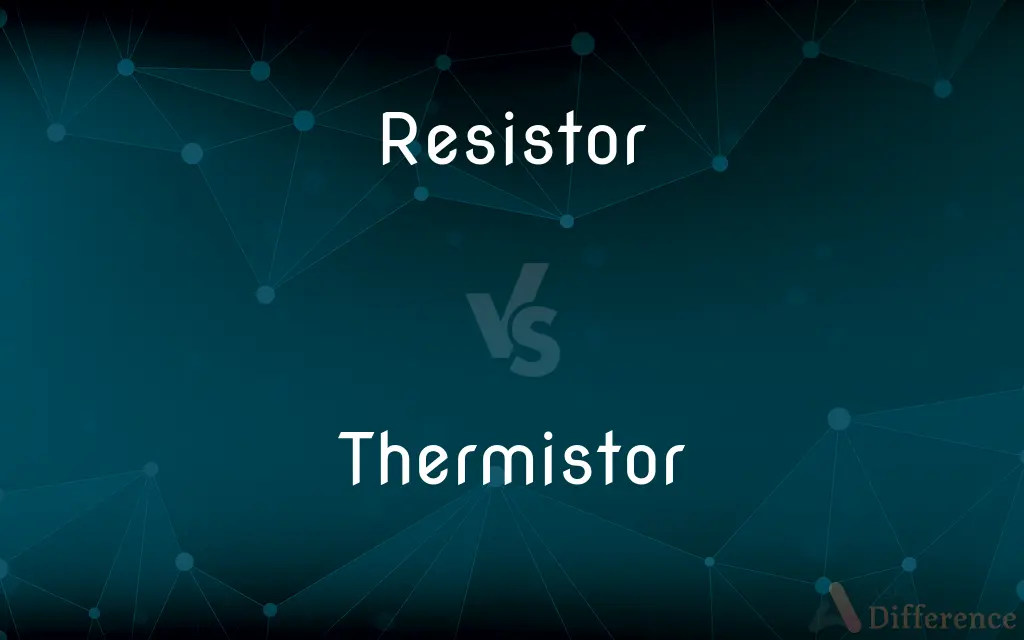Resistor vs. Thermistor — What's the Difference?
By Fiza Rafique & Maham Liaqat — Updated on April 22, 2024
A resistor is a passive electrical component that resists current flow uniformly, while a thermistor is a type of resistor whose resistance varies significantly with temperature.

Difference Between Resistor and Thermistor
Table of Contents
ADVERTISEMENT
Key Differences
A resistor is designed to have a fixed resistance that impedes electrical current, making it a fundamental component in electronic circuits to control voltage and current levels. On the other hand, a thermistor is a specialized resistor that changes its resistance in response to temperature changes, making it valuable for temperature sensing and protection applications.
Resistors are typically used to set specific electrical characteristics in a circuit, such as voltage division or current limitation. In contrast, thermistors are often utilized in temperature-related applications, such as digital thermometers, overcurrent protection, and temperature compensation, where their resistance change can be used to measure or control temperature changes accurately.
The resistance of a standard resistor is primarily determined by its material, length, and cross-sectional area, and it remains relatively stable over a range of environmental conditions. Conversely, thermistors are made from semiconductor materials, which are more sensitive to temperature changes, leading to a dramatic change in resistance with even small fluctuations in temperature.
Resistors are available in various types, including fixed, variable, and special-purpose resistors like LDRs (light-dependent resistors) and VRs (voltage-dependent resistors). While, thermistors come mainly in two types: NTC (Negative Temperature Coefficient), where resistance decreases with an increase in temperature, and PTC (Positive Temperature Coefficient), where resistance increases with an increase in temperature.
The selection between a resistor and a thermistor in electronic design depends heavily on the function they need to perform. Resistors are chosen for applications requiring consistent performance with minimal influence from temperature, while thermistors are selected for applications where temperature has a significant impact on circuit functionality.
ADVERTISEMENT
Comparison Chart
Resistance Behavior
Typically fixed regardless of temperature changes.
Changes significantly with temperature changes.
Material
Made from metals or carbon compounds.
Typically made from ceramic or polymer semiconductor materials.
Application
Used for controlling current and voltage.
Used for measuring and controlling temperature.
Types
Fixed, variable, special-purpose (LDR, VR).
Mainly NTC (Negative Temperature Coefficient) and PTC (Positive Temperature Coefficient).
Sensitivity
Low sensitivity to temperature.
High sensitivity to temperature changes.
Compare with Definitions
Resistor
A device that opposes the flow of electrical current.
A 10-ohm resistor was used to limit the current through the LED.
Thermistor
A resistor whose resistance varies significantly with temperature.
The thermistor triggered the fan when the system overheated.
Resistor
Often made from carbon film or metal oxide.
The circuit board was populated with several metal oxide resistors.
Thermistor
Employed in overcurrent protection circuits.
A PTC thermistor protected the motor from current surges during startup.
Resistor
Integral to almost every electronic circuit for basic functionality.
The designer included resistors to stabilize the voltage across the microcontroller.
Thermistor
Can be NTC or PTC type, depending on the resistance behavior with temperature.
An NTC thermistor was used for the battery temperature monitoring system.
Resistor
Available in a wide range of fixed and variable resistance values.
He adjusted the variable resistor to achieve the desired circuit behavior.
Thermistor
Commonly used in temperature sensing devices.
The thermistor provided accurate temperature readings in the digital thermometer.
Resistor
Used to control voltage levels across components.
Resistors were placed in series with the capacitors to prevent overcharging.
Thermistor
Highly sensitive, making it ideal for precision temperature control.
Thermistors controlled the temperature within critical sections of the spacecraft.
Resistor
A resistor is a passive two-terminal electrical component that implements electrical resistance as a circuit element. In electronic circuits, resistors are used to reduce current flow, adjust signal levels, to divide voltages, bias active elements, and terminate transmission lines, among other uses.
Thermistor
A thermistor is a type of resistor whose resistance is strongly dependent on temperature, more so than in standard resistors. The word is a combination of thermal and resistor.
Resistor
A device used to control current in an electric circuit by providing resistance.
Thermistor
A resistor made of semiconductors having resistance that varies rapidly and predictably with temperature.
Resistor
One who resists, especially a person who fights against an occupying army.
Thermistor
(electronics) A resistor whose resistance varies rapidly and predictably with temperature and as a result can be used to measure temperature.
Resistor
(electronics) An electric component that transmits current in direct proportion to the voltage across it.
Thermistor
A semiconductor device made of materials whose resistance varies as a function of temperature; can be used to compensate for temperature variation in other components of a circuit
Resistor
An electrical device that resists the flow of electrical current
Common Curiosities
How does a thermistor work?
A thermistor changes its resistance in response to temperature changes, which can be monitored or used to control a circuit.
What is the primary function of a resistor?
A resistor primarily limits or regulates the flow of electrical current in a circuit.
What materials are typically used to make resistors and thermistors?
Resistors are usually made from carbon or metal films, while thermistors are made from sensitive ceramic or polymer materials.
Can resistors be used to reduce noise in electronic circuits?
Yes, resistors can be used in a circuit to reduce electrical noise or filter signals.
What are the typical resistance ranges for resistors and thermistors?
Resistors can range widely from ohms to megaohms, while thermistors typically have a more focused range tailored for temperature sensitivity.
What is the reliability of thermistors in extreme conditions?
Thermistors are reliable under a broad range of temperatures, but their performance can be tailored to specific applications with extreme conditions.
Why choose a resistor over a thermistor for a circuit?
Choose a resistor when stable resistance is required regardless of temperature changes.
How are resistors and thermistors integrated into electronic circuits?
Resistors are often used for setting voltages within a circuit, whereas thermistors are integrated into temperature-sensitive applications.
How do environmental factors affect resistors and thermistors?
Resistors are generally stable under environmental changes, while thermistors' resistance can vary significantly with temperature changes.
Can thermistors be used for applications other than temperature sensing?
Yes, thermistors are also used in overcurrent protection and as inrush current limiters.
What are the testing methods for resistors and thermistors?
Testing involves measuring resistance under various conditions, ensuring it meets specific criteria for stability and performance.
How is the temperature coefficient important in the context of thermistors?
The temperature coefficient determines how the resistance of a thermistor changes with temperature, crucial for its application.
Are there any safety concerns with using thermistors?
Thermistors must be carefully selected and implemented to handle the expected temperature ranges without degrading.
What are some common failures in resistors and how are they prevented?
Resistor failures can include burning out or value drift due to overheating; these are prevented through correct rating and design.
What advanced technologies utilize thermistors?
Thermistors are used in advanced technologies such as smart climate control systems and precision temperature monitoring in medical devices.
Share Your Discovery

Previous Comparison
Survey vs. Research
Next Comparison
Confident vs. UnconfidentAuthor Spotlight
Written by
Fiza RafiqueFiza Rafique is a skilled content writer at AskDifference.com, where she meticulously refines and enhances written pieces. Drawing from her vast editorial expertise, Fiza ensures clarity, accuracy, and precision in every article. Passionate about language, she continually seeks to elevate the quality of content for readers worldwide.
Co-written by
Maham Liaqat















































